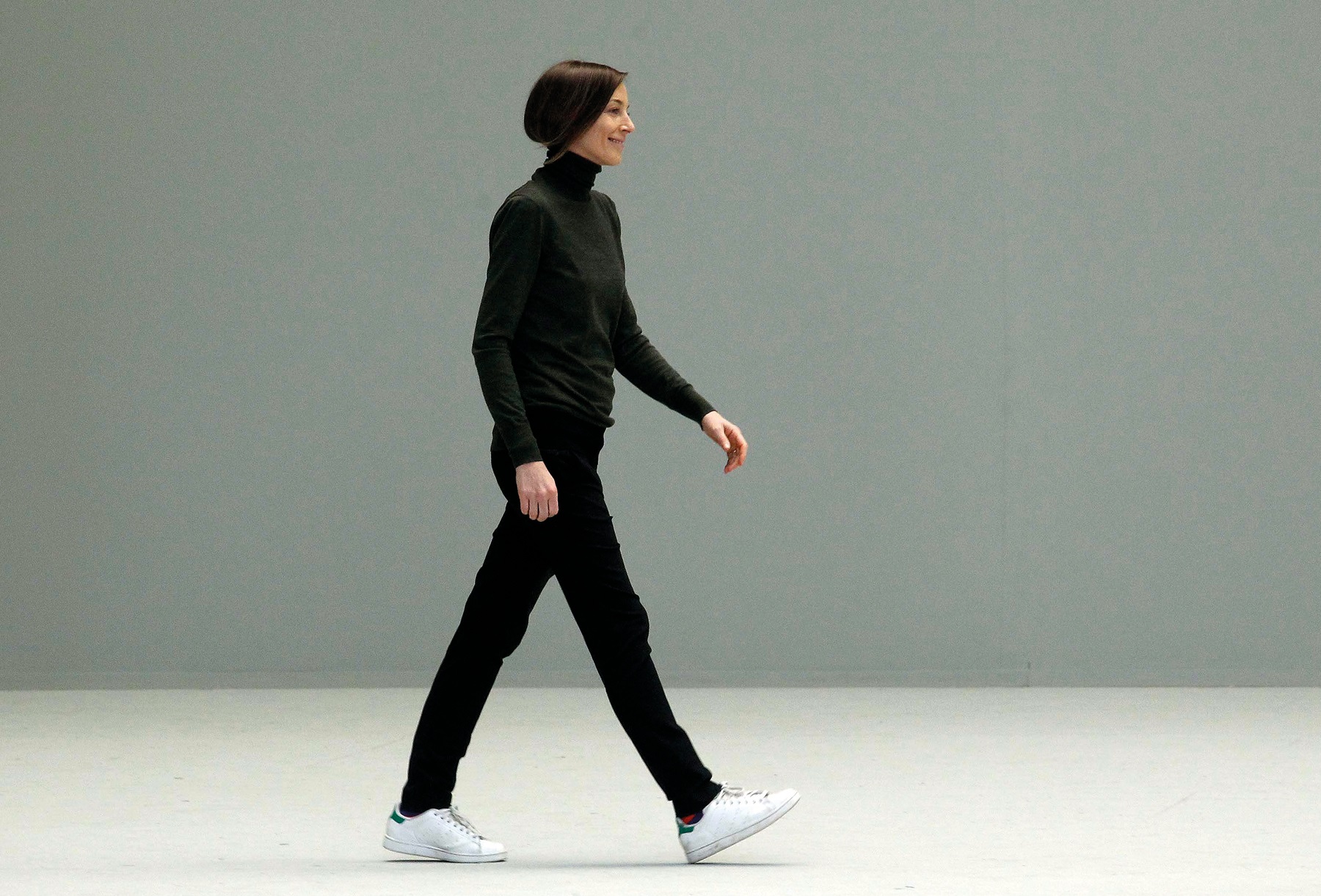
334 Phoebe Philo walks the runway during the Céline Ready to Wear Autumn/Winter 2011/2012 show during Paris Fashion Week.
Political engagement has become the defining character of fashion production and media in the 2010s. This is unprecedented. During this period, the fashion industries have highlighted issues surrounding racism and sexism; LGBTQIA+ (lesbian, gay, bisexual, transsexual, queer/questioning, intersex, asexual and all people who do not identify with the traditional gender binary) rights; mental health awareness; body, skin (colour and pigmentation) and age diversity; and global sustainability. Fashion design, runway shows, editorials, image-making, and the sharing of personal stories from industry insiders, including a number of models, and mostly via social media, have variously brought these issues to the fore of fashion discourse.
The digital image-sharing platform Instagram, launched in 2010, is fashion’s dominant social medium, permitting designers to live-stream catwalk shows and share behind-the-scenes insights and new product information. In 2018 it is available in thirty-six languages and reaches 1 billion active users each month. Significantly, communication is two-way, and companies are ‘named and shamed’ by their customer base where injustices – such as exploitation and plagiarism – are perceived. Some Instagram accounts exposing apparent copies, notably Diet Prada, have become so influential that major international brands have felt compelled to issue clarifications, apologies and withdraw products and campaigns.
In 2017 Gucci were compelled to acknowledge that a jacket featured in their cruise collection was based upon a balloon-sleeved jacket emblazoned with the Louis Vuitton logo that Harlem-based couturier Dapper Dan had created for the Olympic sprinter Diane Dixon in 1989. A self-taught designer, Dapper Dan established his business in 1982 and became famous for his illicit and extravagant appropriation of luxury-brand logos on clothing. His black clientele felt alienated by luxury retail environments and lack of suitable sizing, and adored his subversive designs. Ten years later litigation from the luxury brands put Dapper Dan out of business. In an unusual twist of fate, in 2017 Gucci invited Dapper Dan to form a collaboration, funded the reopening of his Harlem atelier and featured the designer in a tailoring campaign.
Designers continue to determine fashion styles, but celebrities that have become known as ‘influencers’, including stylists and models with huge followings on social media, now exert a powerful hold on what is purchased and how it is used and worn, with the most successful securing sponsorship and brand commission. As in the 2000s, multiple trends continue to co-exist and are available at all market levels.
Normcore, a term coined in 2013 by the New York trend-forecasting group K-Hole, describes the ‘anti-style’ vogue for understated and unembellished outfits in neutral tones. Unlikely fashion icons, Jerry Seinfeld and Larry David are frequently referenced as exemplars. It is a look that can be put together inexpensively from the high-street stores Gap, Cos and Uniqlo and at designer level is exemplified by Phoebe Philo’s designs for Céline, which has become one of the most influential houses of the 2010s.
Formerly at Chloé, Philo designed for Céline between 2008 and 2018, during which time the house saw its profits triple. Philo, who personifies her fashion aesthetic, engaged a loyal following of women attracted to her modern, wearable collections. When the designer took a bow at her Spring/Summer 2011 show wearing Stan Smith for Adidas trainers, the footwear became a fashion staple.[334] Philo was responsible for the vogue for menswear silhouettes for women – loosely tailored shirts, jackets, trousers, trench and Crombie coats – caramel colours, the luggage tote bag, fur-lined Birkenstock-style sandals, midi-length skirts and loose, soft leather trousers and T-shirts. Many of her comfortable, sporty styles fed directly into, and reinforced, the athleisure trend.
Athleisure is fashion apparel that can be worn both for exercise and as everyday wear. Key ranges include Lululemon, Opening Ceremony, Adidas by Stella McCartney and Yohji Yamamoto’s Adidas Y-3 ranges. Kanye West’s Yeezy collections and Beyoncé’s Topshop collaboration, Ivy Park, have also become top-selling athleisure brands. West and Beyoncé are among a number of musicians and reality-TV stars who have successfully entered the fashion and beauty industries.

334 Phoebe Philo walks the runway during the Céline Ready to Wear Autumn/Winter 2011/2012 show during Paris Fashion Week.
Menswear is a major growth market and the 2000s trend for tight tailoring – led by Hedi Slimane – has generally given way to looser silhouettes. In 2018 LVMH announced that Slimane would replace Philo at Celine (re-presented without the accent) and that the company would introduce a menswear line. Slimane and Raf Simons (designer at Calvin Klein between 2016 and 2018) are among the leading menswear designers, along with Lucas Ossendrijver at Lanvin, Thom Browne, Craig Green, Alessandro Michele at Gucci, Tom Ford, Kim Jones at Dior Homme (since 2018, formerly at Louis Vuitton) and Virgil Abloh, designer of the Off-White label and at Louis Vuitton since 2018.
Style magazine Arena Homme+, launched in 1994 by Kathryn Flett, remains instrumental in disseminating menswear trends, as have more recent biannual publications Another Man (founded in 2005 by Jefferson Hack, London) and Fantastic Man (also established in 2005, edited by Jop van Bennekom and Gert Jonkers, Amsterdam), along with the more subversive Buffalo Zine (launched in 2011 by David Uzquiza and Adrián González-Cohen).
Noteworthy new generation designers include Charles Jeffrey and Grace Wales Bonner, both of whom trained at Central Saint Martins, London, launched their labels in 2015 and are recipients of prestigious LVMH Young Designer awards. Jeffrey’s Loverboy label confronts menswear canons – he uses padding to create sculptural silhouettes, drapery (very unusual in menswear), oversize tailored jackets with huge shoulders and belted waists, mismatched patterns (often tartan in homage to his Scottish heritage), primary colours and bold, graffiti-style graphics. His runway shows have revived the performativity of London’s 1980s queer club scene. Jeffrey is also senior contributing editor for Love magazine.
Wales Bonner also juxtaposes gendered sartorial conventions, creating designs such as Swarovski-crystal skull caps and Chanel-style jackets for men, made using crushed velvet and hand-decorated with cowrie shells. However, the thrust of this designer’s work is motivated by her fascination with cultural hybridity, including her own Afro-European identity. Depictions of black men, historically portrayed as exotic, ‘other’ and hypermasculine, along with self-representations drawn from the 1970s blaxploitation cinematic movement, consistently inspire the design and presentation of her work. Wales Bonner is a skilled tailor, making many designs in white fabrics, and is also known for luxury activewear

335 A model walks the runway at the Wales Bonner Salon show designed by Grace Wales Bonner during The London Collections Men Spring/Summer 2017 show on 12 June 2016.
Selly Raby Kane (formerly working as Seraka), who forms part of a thriving Dakar-based artist collective, is another rising star. Her work is inspired by surrealism (she often uses eyeball and lip imagery), sci-fi film, Pop Art, graffiti (particularly the work of Banksy) and cartoons. Decorative motifs inspired by these sources are applied to, and juxtaposed with, West African textiles and modern materials such as PVC and fake hair. The launch of Raby Kane’s Alien Cartoon collection in 2014 saw the transformation of Dakar’s old railway station into a futuristic fantasy environment with a giant fake octopus and models wearing zany, three-dimensional garments and neon-coloured spacesuits. Alongside her more conceptual work, Raby Kane creates more wearable fashion garments. Like a number of contemporary young creatives she works across disciplines, including film.
Black Lives Matter, an organization that fights for racial equality and justice for the African-American community, was founded in 2013 by Patrisse Cullors, Alicia Garza and Opal Tometi. It has become a powerful international movement and its impact has been widely felt within the fashion industries.
In 2017 Ghanaian-born Edward Enninful (formerly creative director of W magazine and fashion director of i-D) was appointed editor of British Vogue. Enninful declared, ‘I’m black, I’m gay, I’m not rich and I’m not thin’: he is emphatic that diversity will form the basis of the magazine’s new language. Enninful’s first issue, for December 2017, featured Adwoa Aboah on the cover, photographed by Steven Meisel. Aboah, a British model and activist with Ghanaian heritage who has shared her struggles with drugs and mental health issues via Gurls Talk, the online community platform she founded in 2015, has been hailed as the supermodel of our times.
A number of influential magazine editors chose women of colour for the covers of their top-selling 2018 September issues (which feature the Autumn/Winter collections). Beyoncé was photographed for US Vogue, Rihanna for UK Vogue and models Zendaya for Marie Claire, Slick Woods for Elle and Tiffany Haddish for Glamour. Their commercial success dispelled the perception that magazines featuring people of colour on their covers do not sell well. Tyson Beckford, Armando Cabral, Alpha Dia and Alton Mason are among the most successful black male models.

336 Petra Collins, Dakota Johnson, Alessandro Michele and Hari Nef attend the Gucci Bloom launch event at the Museum of Modern Art, New York, on 2 May 2017.
At the same time, there has been a significant increase in transgender and non-binary representation on the runway, in fashion campaigns and in editorials. Casey Legler, a former Olympic swimmer, was the first woman to sign to the men’s board at Ford Models, paving the way for non-binary models such as Oslo Grace. Carmen Carrera, Isis King, Ines Rau, Munroe Bergdorf, Lea T and Andreja Pejić are top-level trans women fashion models. Among a more slowly growing cohort of trans men models are Aydian Dowling and Benjamin Melzer, the latter of whom appeared on PETA’s ‘I’d rather go naked than wear fur’ campaign in 2016.
The first openly trans model to be signed by top American agency IMG, Hari Nef, who is also a trans-activist, is the face of Gucci perfume under Michele’s creative directorship. Michele’s transformation of the house includes leading the maximalism (‘more is more’) trend. This comprises mixing and mismatching brilliant colours, patterns, textures (particularly ruffles) and embellishments. Also explored by Versace, Etro and Miu Miu, it is an eclectic style that references streetwear, world clothing, 1970s disco and 1980s and 1990s pop culture. As a result, this and other trends which reference fashion’s past have helped maintain the flourishing market for vintage clothing. Nonagenarian businesswoman Iris Apfel is a maximalist style icon.
There exists a small, but growing, demand for apparel that is not explicitly designed for men or women and which can accommodate all body types. In 2015 the fashion-forward London store Selfridges commissioned ‘Agender’, a pop-up gender-neutral installation designed by Faye Toogood. (Experiential retailing like this challenges fashion’s digital economy.) Gender-neutral fashion can also be seen in the designs of Jan-Jan van Essche, whose annual collections reference world clothing traditions and GmbH, established by Serhat Isik and Benjamin Alexander Huseby with collaborators in Berlin, who, like Essche, also reject fast fashion, crafting ‘wardrobe essentials’ from deadstock materials (old, unused fabrics). In 2018, just one year after the Art School collective label was founded in London, the work of design duo Eden Loweth and Tom Barratt, who foreground their focus on non-binary fashion, was attracting much attention. The influence of this development can be seen on the high street with, for example, Zara’s range of ‘ungendered’ T-shirts and the manufacture of gender-neutral merchandising mannequins.
In spite of the many initiatives and high-profile individuals who advocate for body positivity and diversity, tall and extremely thin remains fashion’s favoured body type. However, there are significantly more plus-size models than in the past. Self-identifying as curvy, Ashley Graham is one of the world’s most highly paid models. Rihanna, pop star, designer and recipient of the 2017 Harvard Humanitarian of the Year award, has, by publicly celebrating her own curvaceous and fluctuating silhouette, inspired others. Her lingerie label, Savage X Fenty, caters for a wide range of body shapes and sizes, while her cosmetics line Fenty caters for all skin tones.
The beauty and grooming industries have flourished in the 2010s, greatly boosted by the rise of the selfie and the desire to look good online. The vogue for bushy-looking eyebrows, popularized by top model and actor Cara Delevingne, has prompted new product ranges such as those by Glossier and for permanent make-up tattooing. Likewise, the fashion for highly groomed beards has seen the launch of specialist products. Facial contouring – which looks good in photographs – was popularized by Mario Dedivanovic (who has 6 million followers on Instagram), make-up artist to reality-TV star Kim Kardashian West. The Kylie Cosmetics brand, launched in 2015 by Kylie Jenner, American reality-show star, entrepreneur and half-sister of Kardashian West, caters for this market and is so successful that Jenner, estimated to have a net worth of $900 million in 2018, became America’s youngest self-made billionaire in March 2019.
The Korean market for grooming and beauty products for men, as well as women, has become a global phenomenon aided significantly by South Korea’s mammoth tech industry and championing of visual social media platforms. Alongside the dissemination of a unisex, sports-luxe fashion aesthetic (typified by brands Wooyoungmi and Juun.J), Korea’s beauty revolution has been exported as part of a wider global wave of K-pop culture. G-Dragon and Taeyang – members of the boy band Big Bang – are among the country’s most popular male style and beauty idols. Chanel’s first cosmetics range for men, Boy de Chanel, debuted in South Korea in 2018. China and India remain major growth economies, with India overtaking China’s lead as the fastest growing major world economy in 2018.
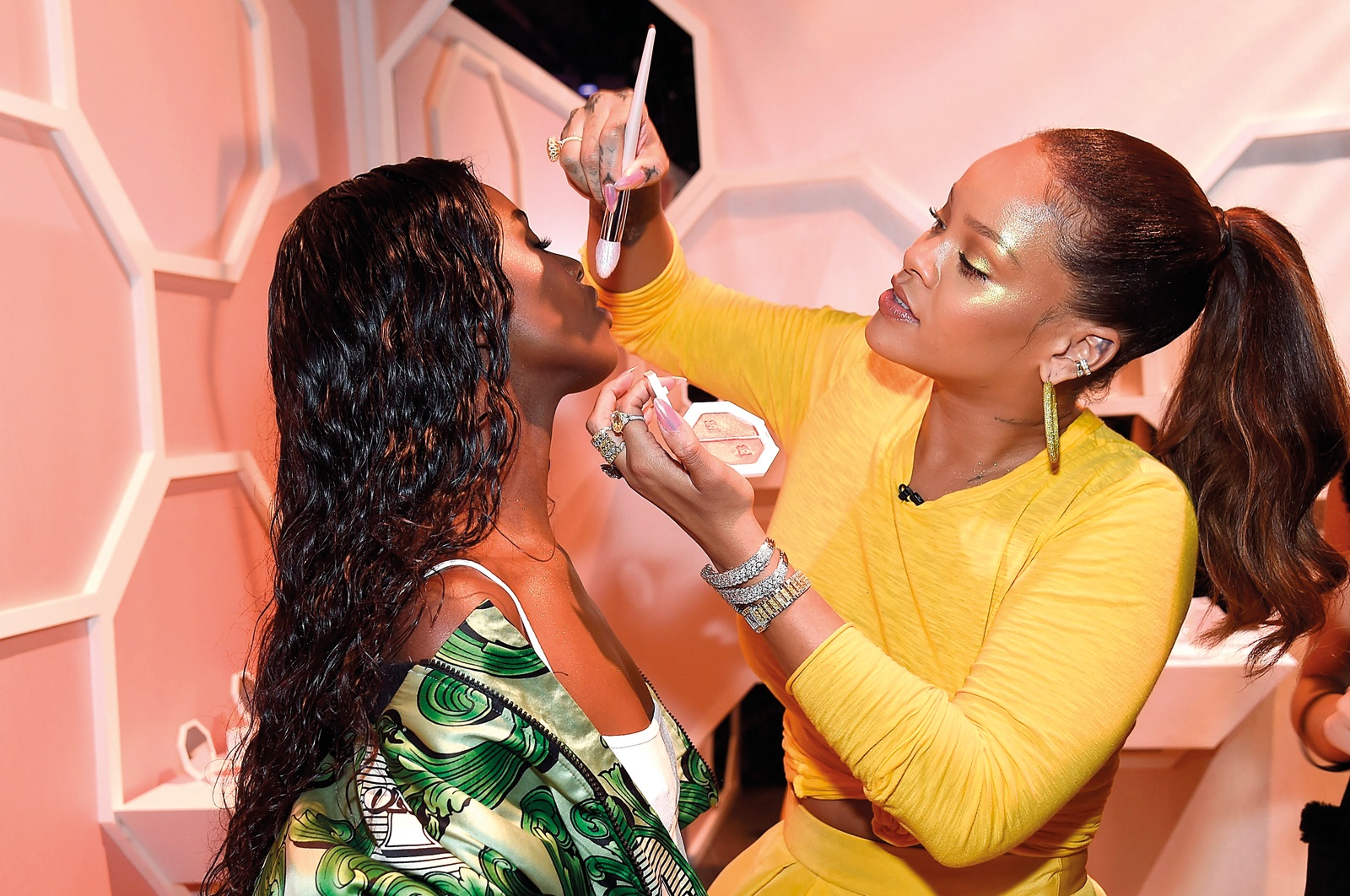
337 Rihanna celebrates the launch of Fenty Beauty at Duggal Greenhouse in the Brooklyn borough of New York on 7 September 2017.
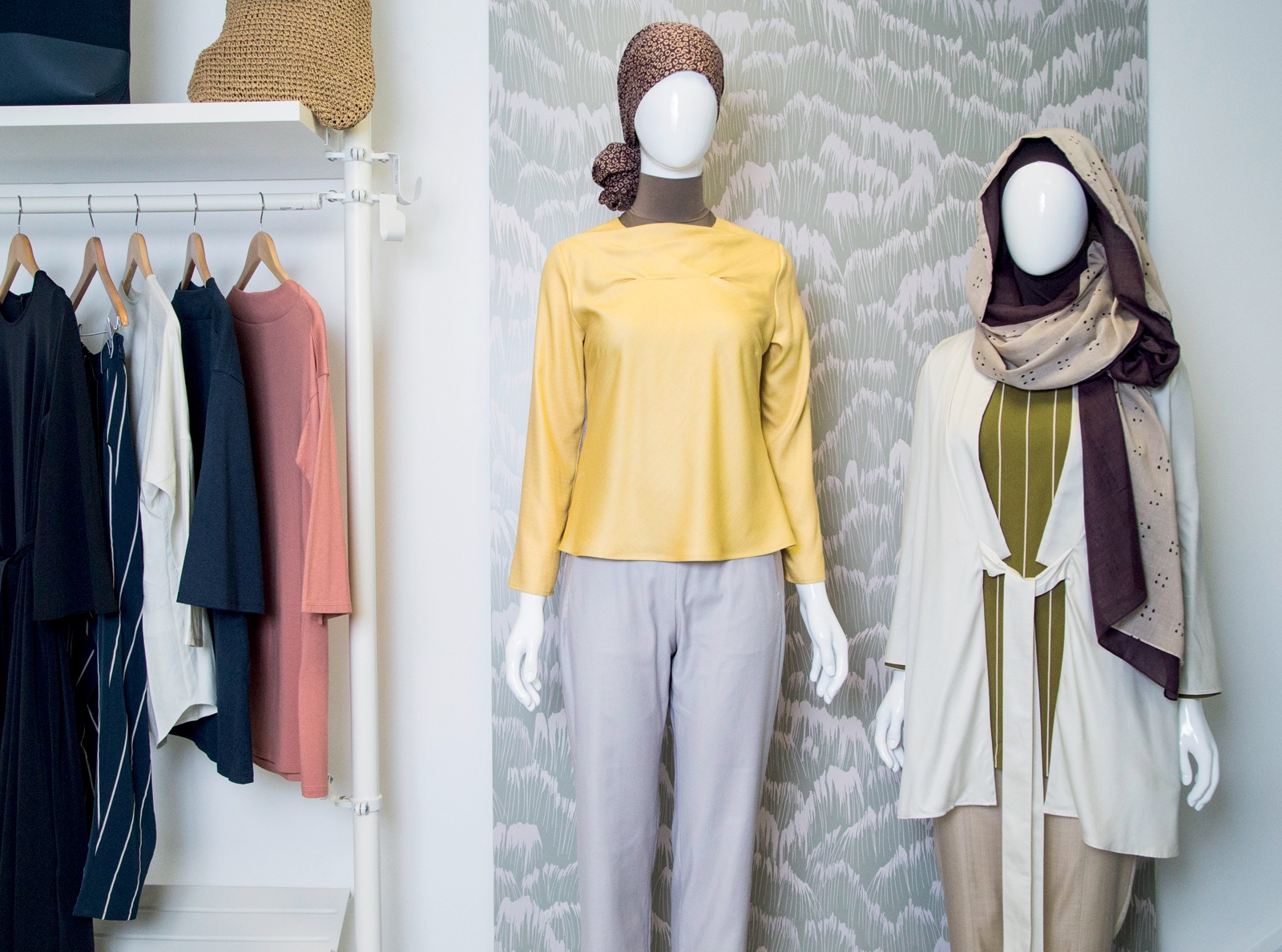
338 Designer Hana Tajima displays various pieces in her collection of modest wear as Uniqlo gets ready to debut a line of hijabs for the first time, 2017.
The Parisian haute-couture industries remain the pinnacle of elite fashion luxury – the term luxury has become a key marketing term of the decade – and serve a small, immensely wealthy, global clientele of some 4,000 women. In 2018 the coterie comprised some twenty houses, including Giorgio Armani Privé, Chanel, Dior (Maria Grazia Chiuri, the house’s first female director, was appointed in 2016), Jean Paul Gaultier, Givenchy, Iris Van Herpen, Georges Hobeika, Elie Saab, Saint Laurent, Giambattista Valli, Valentino and Atelier Versace. In 2013 industry newcomers London-based Ralph & Russo (established in 2007 by Australians Tamara Ralph and Michael Russo) and in 2016 Vetements (established in 2009 by Georgian designer Demna Gvasalia) received a rare accolade in being invited to show as part of Paris haute couture.[340, 341] New houses are rare, as investors have shown a distinct preference for reviving houses from fashion’s past such as Schiaparelli (in 2014), Vionnet (2017) and Poiret (2018).
When British royal Prince Harry announced his engagement to Hollywood actress Meghan Markle the world’s eyes were drawn to the couture houses, amid much speculation about who would design her wedding gown. On 19 May 2018 Markle appeared resplendent wearing a stunningly minimal, trained gown by British designer Clare Waight Keller for Givenchy Couture. For the evening reception she wore a bias-cut, high-necked dress by Stella McCartney. Markle, who is of African-American and Dutch-Irish parentage, is a feminist and human rights activist.
Modest fashion (a term introduced in the mid-2000s which describes a self-awareness in covering parts of the body) has become a major international growth market. Mostly worn by women of the Abrahamic faiths (Judaism, Christianity and Islam), it also resonates with many non-religious women. The fashion industries have proactively catered for this market since the mid-2010s: Ramadan collections were introduced by Donna Karan in 2014 and Oscar de la Renta in 2015. In 2016 Dolce & Gabanna received criticism for not using Muslim models when launching their collection of hijabs and abayas. Conversely there was a media sensation when H&M chose Mariah Idrissi as their first hijab-wearing model for their Close the Loop video campaign, which encourages recycling, in 2015. Muslim designer Hana Tajima has collaborated with Uniqlo since 2015, Mango introduced a modest-fashion range in 2016 and Nike introduced the first sports hijab in 2017. Modest-fashion blogger Ruba Zai, Youtuber Dina Tokio and vlogger NabiilaBee (whose Youtube account has attracted over 16.5 million views) have been instrumental in raising awareness and disseminating information and modest-fashion tutorials around the globe.
Alongside Seoul, Tbilisi, Moscow and Kiev have become the latest additions to the world’s fashion capitals. ‘Post-Soviet’ is a term much used by the Western fashion media to describe the work of Eastern bloc designers such as Gosha Rubchinskiy (born in Moscow), Demna Gvasalia and Russian stylist Lotta Volkova, who are at the forefront. Their work references 1990s skater styles and includes streetwear that incorporates urban motifs, Cyrillic designs and brand appropriation. Rubchinskiy showed his first, self-funded, collection in a Moscow stadium and has, since 2012, operated under the Comme des Garçons umbrella. His high-profile collaborations include Levis, Dr. Martens, Reebok and Burberry. Gvasalia studied at the Royal Academy of Fine Arts, Antwerp, later heading design teams at Maison Margiela and Louis Vuitton. Vetements has shown in Paris since 2014: cult ‘it’ items include 2015’s DHL courier T-shirt and 2016’s Bic lighter-heel sock boots. In 2015 Gvasalia was appointed creative director of Balenciaga, a role he undertakes alongside his work as head designer at Vetements.

339 A guest is seen wearing a Supreme hoodie outside the Christian Siriano show during New York Fashion Week, 8 February 2019.
As social media shares news within moments, it is difficult for underground activities and subcultures to flourish unnoticed. In the 2010s sub-cultural identity has taken on new meanings that can comprise digital presence and involve ‘hyperconsumerism’. ‘Hypebeasts’ is the name given to those – usually males – who seek out limited-edition streetwear labels such as Supreme, Palace, BAPE, Off-White and Yeezy. The new fashion exclusivity is no longer defined primarily by luxury and the ability to pay. Demand outstrips supply to such an extent that retailers employ bouncers to manage crowds who are prepared to queue on the street for hours to acquire the latest coveted items. There is a major business in resales and bots often secure products online. Exclusive access is also generated by digital membership and online influencers. Female bloggers known as ‘haul girls’ – some of whom have become online influencers – broadcast, often from their bedrooms, items acquired on their latest fashion spree.
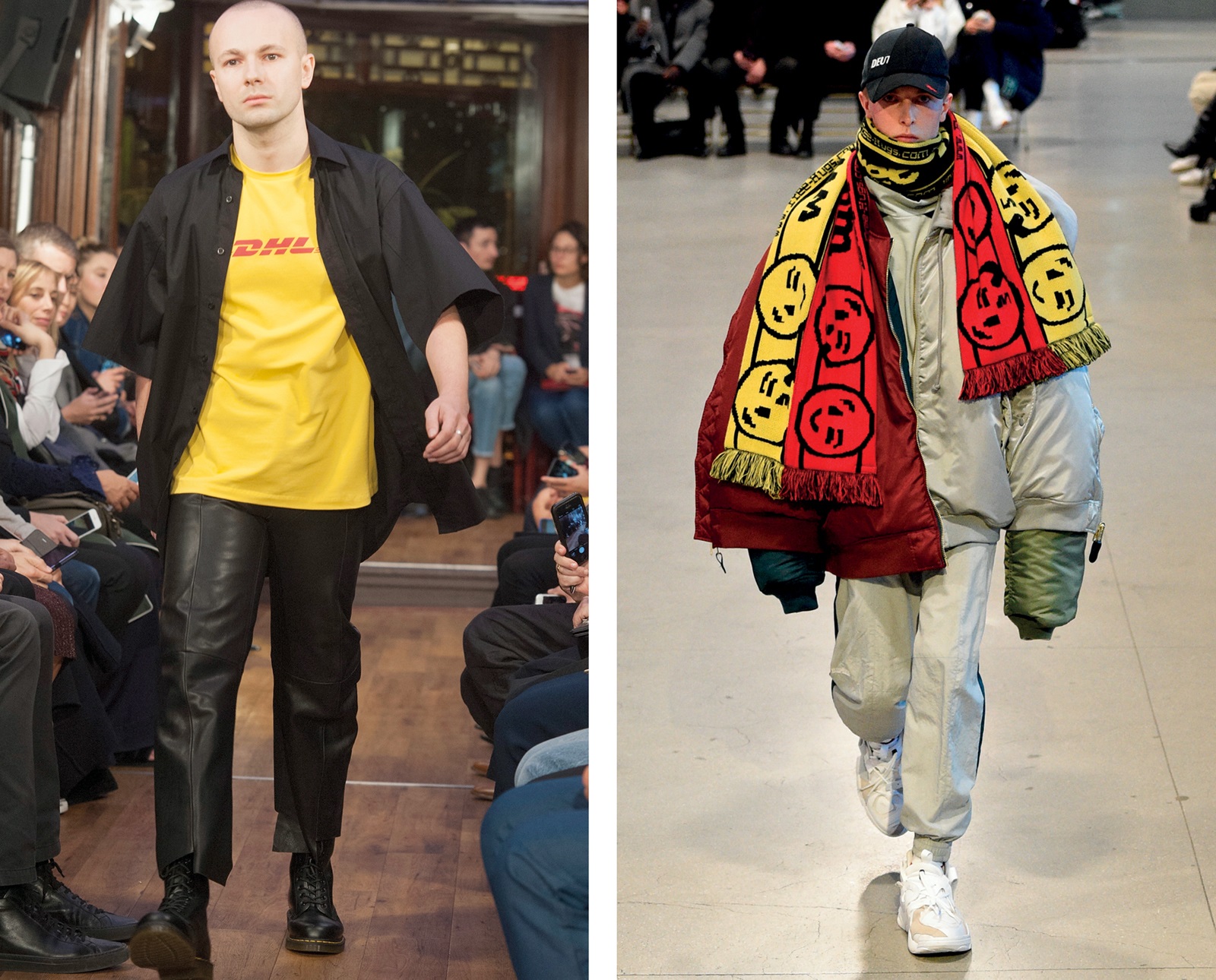
340, 341 The Spring/Summer 2016 Vetements show at Paris Fashion Week.
In a bid to keep pace with social media and capitalize on the demand for runway products, the fashion industry is exploring new models for presenting and making available their products. In February 2016 Burberry (under the creative direction of Christopher Bailey, who was succeeded by Riccardo Tisci in 2018) announced that they were breaking with tradition by showing their men’s and women’s wear collections together in the form of biannual ‘seasonless’ shows. Soon after, Gucci announced that their Autumn/Winter 2017 would also present men’s and women’s wear together. Burberry were also pioneers, along with Tommy Hilfiger, Moschino, Tom Ford, Ralph Lauren and Paul Smith, in developing the ‘immediacy model’ that makes the collection available to consumers following their shows. (It had until then been customary to manufacture only once wholesale orders had been placed, with items offered at retail between four and six months later.) While these moves are aligned to high-street ‘fast fashion’, there has been a backlash from the luxury fashion conglomerates LVMH and Kering, who are of the position that delayed gratification enhances desire.
The backlash against excessive consumerism and fast fashion on the high street has taken the form of the ‘slow fashion’ movement (a term coined by Kate Fletcher in 2007). It is an initiative supported by ethical designers, makers and consumers, who encourage people to buy fewer, high-quality garments (if that is an affordable option) or vintage items, and to remake and mend existing items in order to preserve scarce resources, diminish labour exploitation and to positively affect our overall wellbeing. Slow fashion also feeds into campaigns to preserve the global environment, sustainability and to safeguard biodiversity. The 2010s has seen a significant reduction in the use of real fur and in 2018 London Fashion Week declared itself fur-free. However, concerns have been raised regarding the plastics involved in making fake fur, which have a damaging impact on the environment, especially upon sea life.
The 2010s has seen a groundswell of activism championing inclusivity, diversity and the rights of the individual for freedom of expression. However, it is indeed shocking that so many people are still subject to criminalization and state-sanctioned death (it is still illegal to be LGBTQIA+ in over half the world’s countries), stigmatization and violence because of their dressed appearance, colour, and sexual or gendered identities. As a commercially driven industry, fashion cannot of course right the world’s injustices, but it does have an immensely broad reach. Time will tell if it can – and will – actively effect change.
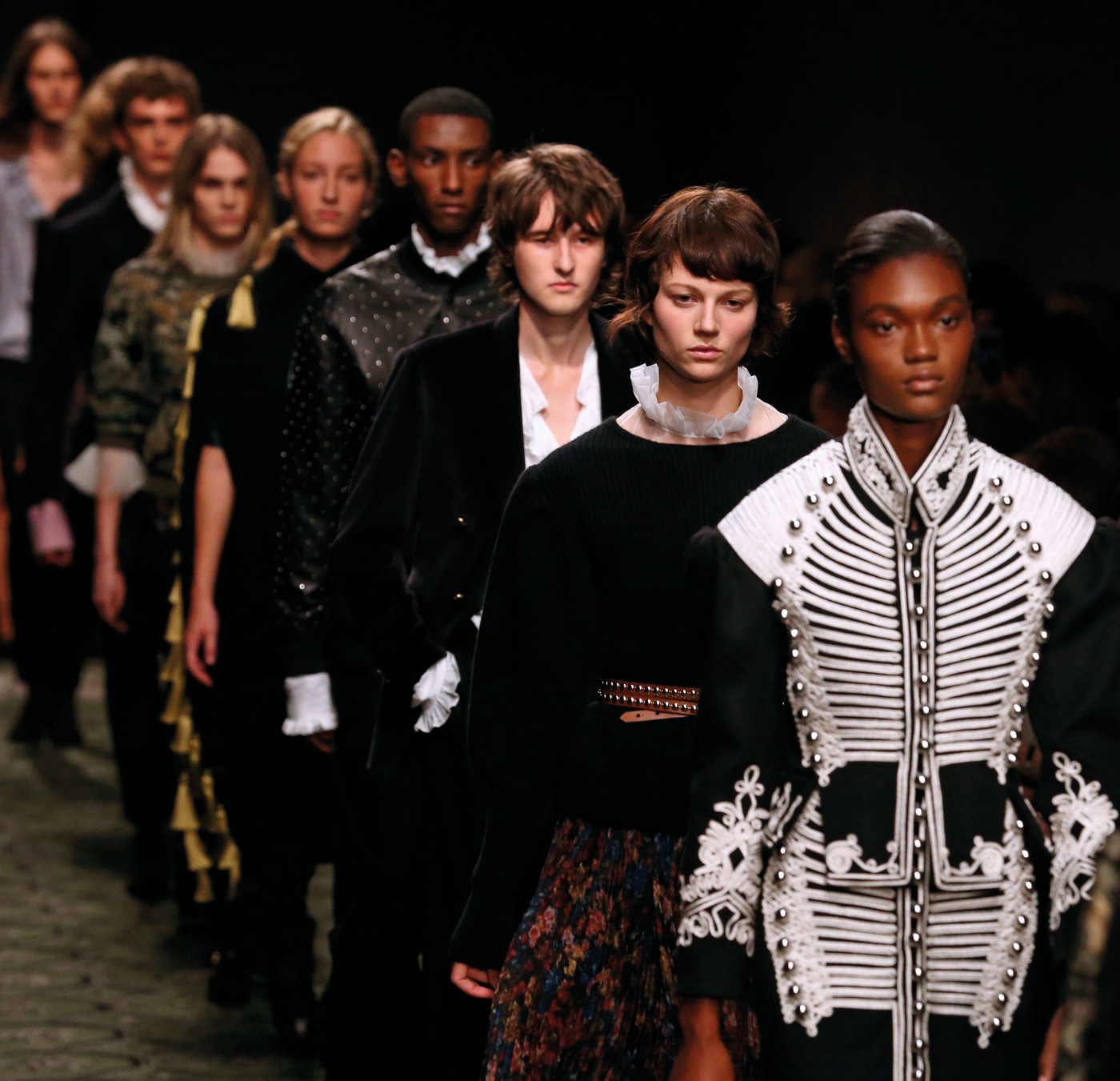
342 Models present creations by Burberry during the 2017 Spring/Summer catwalk show at London Fashion Week, 19 September 2016.